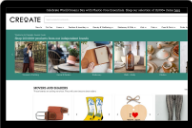
Hannah Dossary is the founder of Shiny Happy Digital, and a professional web designer with over 10 years of experience wrangling code and colours into joyful websites that are packed with personality, and carefully rooted in human psychology.
We caught up with Hannah to discuss all things small business web design; from putting the right colours in the right places, to avoiding common ecommerce pitfalls, and getting the most out of working with a professional designer (if you choose to go down that route).
You can find more design advice on the Shinny Happy Digital website, or follow Hannah on Instagram @shinyhappy.digital. And now, over to Hannah!
Hi Hannah! Can you tell us a bit about your design philosophy over at Shiny Happy Digital?
Hello! Well as you can probably tell from the name, Shiny Happy Digital isn't a vanilla kind of business; it's all about confidently using colour, sparking joy, making design playful, and bringing out my clients’ vibrant personalities in the way that suits them best! That's why I custom design every site I build and put so much love into all my work.
What are some important things to nail down before starting to design your own website?
Before I can start work on a website, I usually check that a client has a few things in place:
- A clear brand strategy. Knowing who your audience is, what your values and goals are, and why your business is unique. If a client doesn't have this figured out, the website that they invest in will keep changing, so it's going to be a big waste of their investment. Everything else follows this important foundation work.
- A strong brand identity. Not just a logo, but a colour palette, brand fonts and if possible, any brand graphics that help to shape their brand. If they don't have this key part of the puzzle, I recommend a few brand designers they might want to work with. It will be one of the best investments they can make.
- Brand photos. Some professional photos of you, your team, and your products go a long way to making sure your website stands out. A few headshots can be enough, but beyond that we'd have to use stock images — which isn't great!
- An idea of what content or text needs to be on the website. You don't need to have all the copy written already, but an idea of what you want to say will help. I always advise my clients and draw out a clear guide of how much text I feel they may need and what goes on each page. Then they can use this as a guide to start writing. It usually helps to see dummy copy in place on the designed site so they can really visualise and write accordingly.

"You need to know who your audience is, what your values and goals are, and why your business is unique. If a client doesn't have this figured out, the website that they invest in will keep changing, so it's going to be a big waste of their investment."
How do you approach building out distinctive but complementary brand colours?
I LOVE working with colours. I'm always amazed at the amount of colour palettes that can be made.
A well-thought-out colour palette will ensure that there’s a different colour for different purposes. Usually there will be a colour that’s best used for accents such as buttons, calls-to-action, or to highlight important information. For the rest of the colours, it's important for me to check how the colour combinations work for accessibility, and I’ll use the ones with higher contrast most of the time.
I also like to ensure there is always balance on the site. As much as I love colour, you can go overboard and give your reader a headache, which isn't great if it results in them leaving your site! So finding the balance of quieter spaces allows the pops of colour to really shine.
📚 Bookmark for later: How to Plan a Successful Product Shoot, with Danni Rossi
Can you share some common mistakes you see small ecommerce businesses making with their website design?
Shopify makes it so easy for small businesses to build their own site, which is amazing! But just because you can build your own website doesn't mean you know how to make it work best for your customers. There's a lot of thought that goes into layout decisions and using customer psychology to build a site.
The top three common mistakes I find that small ecommerce businesses make are:
- Using the homepage to go straight into selling the products. Most of your audience will be new customers who don't know what your business is, and why it was started. It's important to warm up your customers on the homepage with a clear hook, intro, and showing off your USP.
- Making product descriptions too short or too long. This one's a bit of a balancing act; you don't want your text to be so short that you’re not making the most of the opportunity to include keywords and key phrases (which helps with SEO). But you also don't want it to be so long that it’s overwhelming and ends up being ignored completely. Important information should stand out so that anyone who is scanning the text can find what they need to quickly.
- Not optimising their site for mobile. A large portion of website traffic comes from people using their phones. If your site doesn't look right on mobile, or it's clunky to use, it will put a lot of customers off.
📚 Bookmark for later: 10 Easy Optimisations for Your Mobile Ecommerce Site
What’s one thing our community could change or add today to make their website more unique and playful?
Your website should be an extension of your products. If your products are loud, colourful, bold, cheeky or cute, then your site should reflect that personality through bright colours, cute background patterns, handwritten fonts, cheeky copy etc. You can bring personality into just about anything!

"You can bring personality into just about everything!"
What’s a common misconception about working with a professional web designer like yourself?
People often think that working with a professional web designer means that you give up any creative control and don't get much of a say of what the site may look like — that's why a lot of people DIY their site instead. But that couldn't be further from the truth.
From the very first time we talk, it's all about collaboration and hearing your creative voice. My job as a professional is to take your ideas, make sense of them, advise you on what may or may not work, or how we can make it work, and then use my experience to build you a product that you will love because you've been a big part of the process.
It's a lot of problem solving — and small business owners generally already have enough of that on their plate!
Thank you so much for sharing these insights with us, Hannah! Be sure to go follow @shinyhappy.digital on Instagram, or sign up to Hannah’s fortnightly newsletter to get bitesize design tips and behind-the-scenes insights dropped straight in your inbox.








